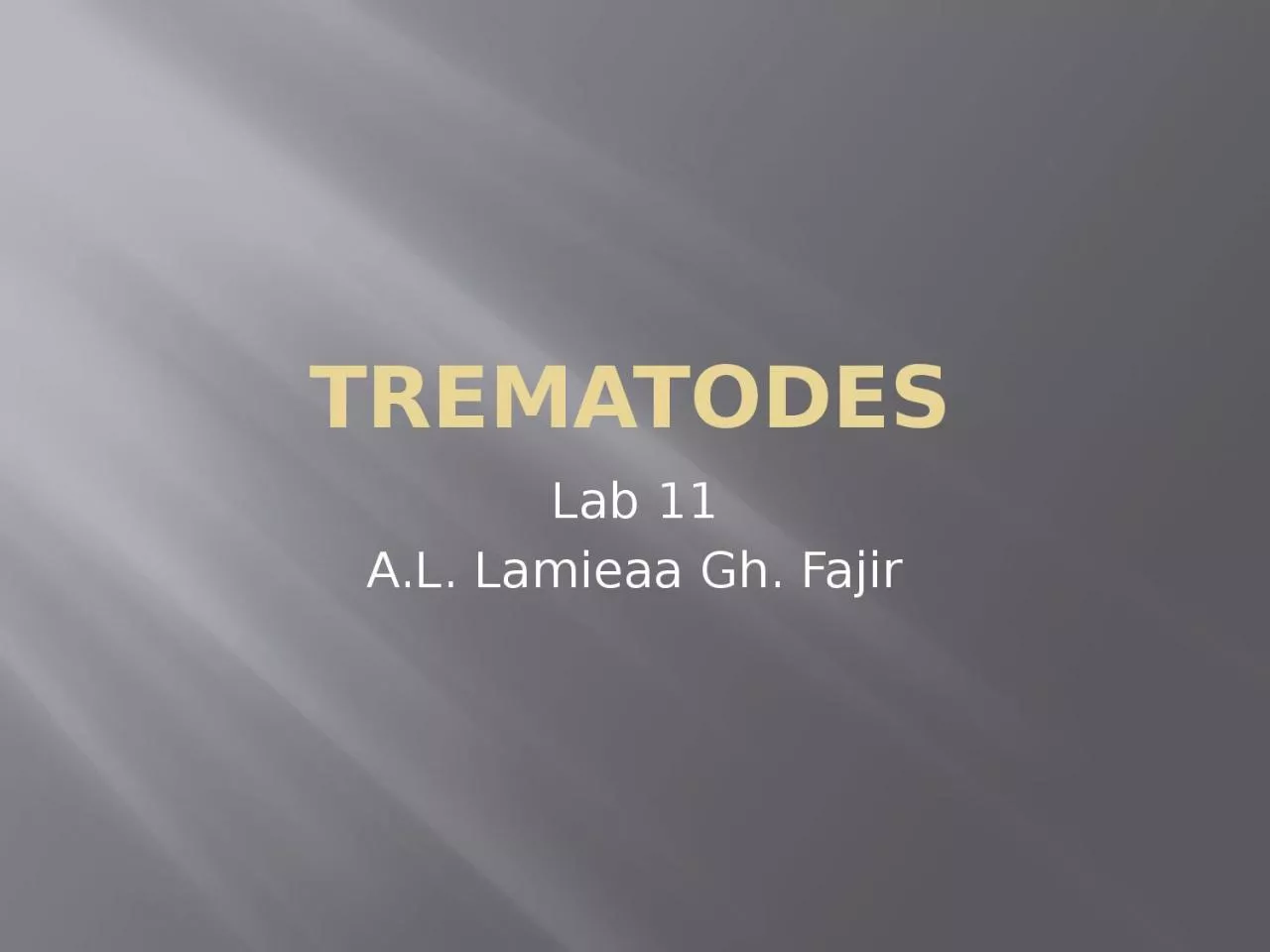

Gh Fajir Classification of trematodes Blood flukes Schistosoma haematobium Schistosoma mansoni Shsistosoma japonicum Liver flukes Fasciola hepatica ID: 1047758
Download Presentation The PPT/PDF document "Trematodes Lab 11 A.L. Lamieaa" is the property of its rightful owner. Permission is granted to download and print the materials on this web site for personal, non-commercial use only, and to display it on your personal computer provided you do not modify the materials and that you retain all copyright notices contained in the materials. By downloading content from our website, you accept the terms of this agreement.
1. TrematodesLab 11A.L. Lamieaa Gh. Fajir
2. **Classification of trematodes **Blood flukes.Schistosoma haematobium.Schistosoma mansoni.Shsistosoma japonicumLiver flukes. Fasciola hepatica / Fasciola gigantic. Clonorchis sinensisLung flukes. Paragonimus wastermani Intestinflukes.Fasciolopsis buski. Heterophyes heterophyes. Metagonimus yokogawai
3. Blood flukes (Schistosomes)There are five main species of schistosomes infect human:1- S. haematobium: occurs primarily in the Old World. Nearly all of Africa and portion of Middle East, including Iraq, Saudi Arabia, and Iran which considered as endemic regions.2- S. mansoni: in Africa esp. Egypt, Sudan and Libya, Arabian Peninsula, and Central and South America.3- S. japonicum: is limited to the Far East (China, Indonesia, and Philippines).4- S. intrcalatum5- S. meckongiS. haematobium, S. mansoni and S. japonicum are the major species that infect human beings. S. intrcalatum and S. meckongi are less common.
4. General features of schistosomes from other trematodes:1-have separated sexes (diecious).2-adults live in blood vascular system.3-adult digestive system has no muscular pharynx, but characterized by formation of single intestinal canal by the union of bifurcated intestinal caeca.4-production of non-operculated eggs (eggs with spine).5-no redia formation.6-have forked tailed cercariae (infective stage to man).7-no metacercariae formation.8-infect human by penetration of unbroken skin by cercariae.
5. Typical lifecyle stage: The general lifecycle stages are as follows:1- Egg – discharged either in open water or in intestine of definitive host.2- Miracidium (plural Miracidia) – free-living motile form, covered with cilia, which settles in the mollusc to become a sporocyst.3- Sporocyst – an elongated sac that produces either rediae or more sporocysts.4- Redia (plural rediae) – a larval form with an oral sucker, it will produce either more rediae, or cercariae.5- Cercaria (plural cercariae) – the larval form of the parasite, developed within the germinal cells of the sporocyst or redia.- A cercaria has a tapering head with large penetration glands.- It may or may not have a long swimming "tail", depending on the species.6- Adult – the fully developed mature stage, capable of sexual reproduction.
6. Transmission is by contact with water containing the infective form of parasite (cercaria) by penetration of unbroken skin
7.
8. Differences between eggs of Schistosoma spS. haematobiumS. mansoniS. japonicumShapeoval with terminal spineoval with lateral spineround with short lateral spineModes of voidingUrinefecesfecesSize (µ)150 × 62Largest 140 × 61Middle 85 × 60Small
9. Diagnosis1-Finding of eggs:A-Eggs of S. haematobium in urine (rarely in stool) by:G.U.E.a- microscopic examination especially in heavy infection (direct wet preparation )b- Concentration method {early stage}.Note :-Midday urine specimen is used for recovery of S. haematobium eggs (the time of peak egg excretion).-More than one sample may be need.-In chronic stage, no egg passed in urine.
10. B-Eggs of S. mansoni and S. japonicum in stool by: G.S.E a-Simple saline smear (wet preparation) in heavy infection.b- Concentration methods 2-Egg-hatching technique: viable ova can be hatched from specimens (urine or stool) and the diagnosis made by examining for miracidia by mixing specimen in water and exposing them to light results miracidia in the supernatant in few hours. 3-Cystoscopy and colonoscopy to:a- See the morphological changes on the inner surface of the bladder orintestine (rectum and colon) such as fibrotic changes.b- Recovery of eggs and examine the histopathological changes in the organwall by biopsy as rectal biopsy.4-Antibody detection can be useful in both clinical management (eg, recent infections) and for epidemiologic surveys
11.
12.